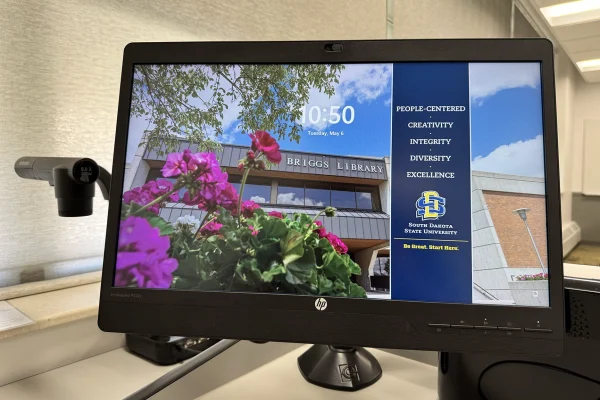Athletic training education program makes transition
January 3, 2019
South Dakota State University’s athletic training education program has been accredited since 1993 and graduated hundreds of students into the field. However, the program is not resting on its laurels.
According to the National Athletic Trainers’ Association, the current minimum entry point into the athletic training profession is a bachelor’s degree. However, the AT Strategic Alliance recently decided the minimum professional degree level will be a master’s degree, a change to be implemented within the next several years.
As a result of the change, South Dakota State made the move to remove its bachelor’s degree program and make some changes to its master’s program to help graduates enter the field.
“Even though we already had a master’s program in place, we used the national information as an opportunity to put a critical eye on our structure,” said Assistant Professor Trevor Roiger, the athletic training program’s director. “We made a lot of changes in content, overall curriculum structure and the timing of pieces in terms of clinical structure. We did these in concert with representatives in our college, the College of Nursing, the College of Pharmacy and Allied Health Professions and an external facilitator.
“We had a program that was in good shape in terms of accreditation but we made a concerted effort to listen to our students, preceptors and employers in terms of where we could improve,” he continued.
South Dakota State master’s degree graduates have been successful; over the past three years, 12 of the 13 students passed the Board of Certification exam their first attempt while the remaining student passed on the second attempt. Eleven of the 13 are currently working as athletic trainers.
In addition to the students’ success from learning in the classroom, the students gain hands-on experiences working one-on-one with patients at a variety of clinical sites, including Jackrabbits student-athletes.
“The SDSU Athletics Sports Medicine Department has worked closely with the athletic training education program for more than 10 years,” said Ben Heinze, SDSU assistant athletic director for sports medicine. “Certified athletic trainers in the sports medicine program are proud to serve as preceptors for the athletic training program and work one-on-one with their athletic training students.
“These athletic training students gain valuable experiences at many sites including all 19 NCAA Division I sports at SDSU,” he continued. “During these experiences, whether they’re practices, games and other clinical experiences, athletic training students can now learn techniques and practice learned skills in a Division I setting.”
Associate Professor Bernadette Olson and Assistant Professor Mary Beth Zwart both said many changes were due to the fact graduate education is different from undergraduate education.
“It is a very different model than what we had previously, but it makes sense in graduate education,” Zwart said, noting how students could complete the coursework before moving into clinicals for an immersive experience. “The students basically go through a strenuous accelerated program, a model that’s typical to what other programs on campus are doing.”
“Students can enter the program after graduating with a four-year degree and come into the two-year graduate program or they can come in after three years as an undergraduate, then utilize credits from the graduate program to complete their undergraduate degree, so there’s one year of work left to complete their graduate degree,” Olson said. “We’re trying to meet the desire and interests of the students while maintaining the integrity of the program.”
This 3/2 model is a nontraditional track to completing the master’s degree in athletic training. A student completes an undergraduate degree in exercise science and the master’s degree in athletic training in five years. The fourth year represents the culminating year of the exercise science degree and the first year of the master’s degree program.
Two members of the first class pursuing a traditional track are Natalie Rihanek and Alec Weis. Both entered the program in May after completing bachelor’s degree programs.
“During my exercise science degree, I knew I wanted to be in a medical profession helping people,” said Weis, who is from Champlin Park, Minnesota, and graduated from Bemidji State University.
“Obviously, I can’t wait to start clinicals—that’s what I’m looking forward to doing,” continued Weis, who would like to work with a collegiate or professional team, preferably one that plays hockey. “I think it’s been super fun and I love all of the classes. There’s obviously a workload change that comes from going from undergraduate to graduate classes. I think starting in the summer helped with that transition and now I’m used to it. I love it; it’s fun and it helps that it applies to what I like and what I do for a career.”
Rihanek, who earned her bachelor’s degree in health education from South Dakota State, made the switch to athletic training because she recalled the impact an athletic trainer had on her brother, who was recovering from injuries during his high school career.
“I saw how it worked, that there was a process to it, and how one could get better with treatment,” said Rihanek, who is from Lynch, Nebraska. “It helped that I knew most of the faculty coming in and was comfortable learning from and working with them.”
Roiger said students’ coursework during their second year in the program is online, an option that allows students to gain clinical experience in and outside of South Dakota, which should help attract students.
“We have a strong tradition in producing graduates who go out and do some amazing work. Two of our most recent graduates work for Great Plains Health in Nebraska,” Roiger said. “They provide high school outreach coverage but also cover 30-40 rodeos in the upper Midwest each year.
“I want to get a couple of years under our belt with the new curriculum and really see it grow. It needs to grow and I know it will; it’ll just take some time.”






















